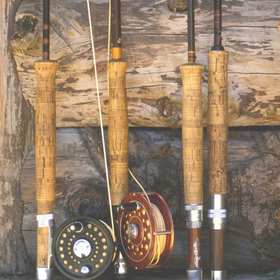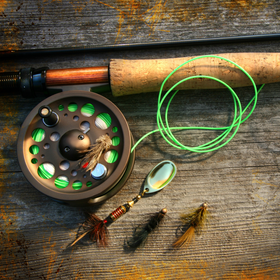Blue Wing Olive and midges hold a place in the hearts of fly fishermen for their year long presence on many rivers. But when hard pressed, many fly fisherman, and all trout, prefer the the big mayfly hatches. The hatches that stir up frenetic activity for us, and a full smorgasbord for trout. The rivers of the Eastern and Midwest United States offer some fabulous hatches that provide just such occasions for frenzied fly fishing action.
While big mayfly hatches are typically short lived, they are somewhat reliable and can be quite intense. They can re-connect us with the reason why we love the puzzle that is fly fishing. Many things affect the exact timing of any specific hatch; water temperature, air temperature, barometric pressure, and time of day. Of equal importance as the hatch itself, is the spinner fall. Spinner falls aren’t as heavily pressured, and since we know the hatch occurrence, their exact timing is more easily pinpointed. Spinner falls are when the adult mayflies return to the water, mate, deposit their eggs and fall to the water, making another easy feast for the waiting trout.
Though they might not qualify as super sized, the Quill Gordons are the first decent sized hatch of the year in many east coast streams. This species needs near perfect water conditions and often disappears from stretches of rivers due to agriculture run off or other man made disturbances. The nymphs are clingers, and are found in fast water due to their need for well-oxygenated water. Because the hatch occurs during a part of the year when the weather can be cold and rainy, the newly emerged dun needs ample time riding the water for their wings to ready for flight. This makes them a nice dun pattern to fish, and a great way to sharpen those dry fly casting techniques rusted from a winter of nymphing.
 - Quill Gordons are the first big mayfly of the year in many places. (photo: www.troutnut.com)
- Quill Gordons are the first big mayfly of the year in many places. (photo: www.troutnut.com)
When the Quill Gordon hatch is winding down, the March Browns are stirring. A sporadic hatcher like the Quill, March Browns spend long periods of time floating on the water. This also makes them a great dry fly hatch for rusty fly fishers. Nymphs move toward shallow, calm areas where rocks are abundant. Emergers struggle mightily to lose their shucks, which also attracts eager trout. A lot of time has been devoted to developing imitations of the March Brown nymph. Our all-time favorites are the Hare’s Ear, March Brown Nymph, March Brown Spider, and March Brown Wet Fly. The nymphs are exposed and vulnerable for quite some time, and anglers should focus on using nymphs with appropriate effort.
 - March Browns often follow the Quill Gordon hatch. (photo: www.troutnut.com)
- March Browns often follow the Quill Gordon hatch. (photo: www.troutnut.com)
Green Drakes can vary from location to location, but the excitement they invoke does not. The east and Midwest both sport great populations of this mayfly. Nymphs are burrowers that emerge from late May through June. The nymphs are exaggerated swimmers, which makes patterns like the Green Drake Poxyback ideal, as the marabou from the pattern accents the gills that are the prevalent feature of these insects. The nymphs will molt up to 30 times per year making them very accessible to trout. Thus, they can be fished year-round where populations are adequate.
 - Green Drake hatches can bring huge trout out of the depths. (photo: www.troutnut.com)
- Green Drake hatches can bring huge trout out of the depths. (photo: www.troutnut.com)
Though the duns are fished as the emergence occurs (and that can be very unpredictable), the spinners fall at dusk. This is much more predictable, and is an ideal time if you want to fish these. Even the name ‘Coffin Fly’ (a common name for Green Drakes) denotes the prime target they are. Green Drake are very nutritious, and due to the intensity of this hatch, the fattest trout pursue them with vigor. This hatch and spinner fall is best fished at the very beginning and then again at the very end of the hatch.
Following the ‘Coffin Fly’ comes the cameo appearance of the Brown Drake sneaking in before the Hex. The nymphs are burrowers living in the sand and the silt. The adult emergence happens at night as do spinner falls and they can be on the water at the same time. Fishing the Brown Drake Paradrake imitates both.
Isonychia, or Slate Drakes, (or Mahogany Duns) begin their emergence in early June in most waters. Unlike the other mayflies in this article, this hatch can last for months. The nymphs are swimmers and can be imitated with Zug Bugs, Sparkle Isonychia, and other full bodied patterns. Nymphs can emerge on shore or in warmer water; they make a noisy emergence in the water attracting fish.
 - Slate Drake Duns can hatch all summer and make for great fishing! (photo: www.troutnut.com)
- Slate Drake Duns can hatch all summer and make for great fishing! (photo: www.troutnut.com)
Of all the sporadic hatches, this one can provide a whole summer of activity. With duns reliably emerging in steady numbers, they are a great hatch to match throughout the summer in a lot of great rivers.
 - Hexagenia, the giant yellow mayfly, can hatch so thick that they can distort weather radar. (photo: www.troutnut.com)
- Hexagenia, the giant yellow mayfly, can hatch so thick that they can distort weather radar. (photo: www.troutnut.com)
The granddaddy of all large Mayflies is of course the Hexagenia, or "Hex". Calendars are circled, vacations are made, and sleep is lost, for this one insect. The Hex is perhaps most famous in Michigan’s Au Sable River but also significant in regions both East and West. The adults get to size 4, but better results seem to occur with 6 and smaller. Nymphs are burrowers and live for two years. But they molt outside their burrows many times a year, making the nymphs important food for trout and steelhead if present. Hatches generally occur in the waning twilight. This event single handedly created an industry of Michigan night fishing trips.




